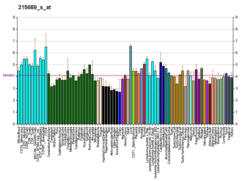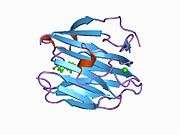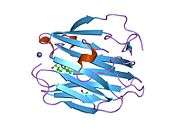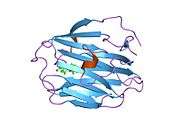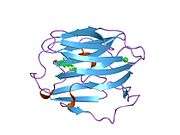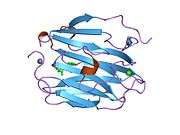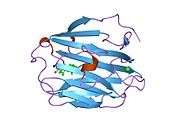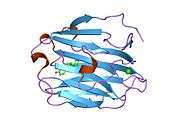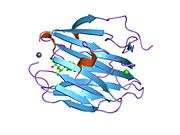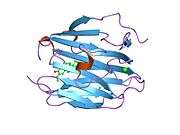Sex hormone-binding globulin
Sex hormone-binding globulin (SHBG) or sex steroid-binding globulin (SSBG) is a glycoprotein that binds to androgens and estrogens. Other steroid hormones such as progesterone, cortisol, and other corticosteroids are bound by transcortin. SHBG is found in all vertebrates apart from birds.[5]
| SHBG | |||||||||||||||||||||||||
|---|---|---|---|---|---|---|---|---|---|---|---|---|---|---|---|---|---|---|---|---|---|---|---|---|---|
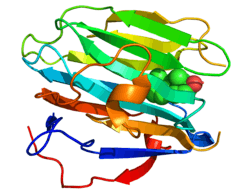 | |||||||||||||||||||||||||
| |||||||||||||||||||||||||
| Identifiers | |||||||||||||||||||||||||
| Aliases | SHBG, ABP, SBP, TEBG, sex hormone binding globulin, Sex hormone-binding globulin | ||||||||||||||||||||||||
| External IDs | OMIM: 182205 MGI: 98295 HomoloGene: 813 GeneCards: SHBG | ||||||||||||||||||||||||
| |||||||||||||||||||||||||
| |||||||||||||||||||||||||
| |||||||||||||||||||||||||
| Orthologs | |||||||||||||||||||||||||
| Species | Human | Mouse | |||||||||||||||||||||||
| Entrez | |||||||||||||||||||||||||
| Ensembl | |||||||||||||||||||||||||
| UniProt | |||||||||||||||||||||||||
| RefSeq (mRNA) |
| ||||||||||||||||||||||||
| RefSeq (protein) |
| ||||||||||||||||||||||||
| Location (UCSC) | Chr 17: 7.61 – 7.63 Mb | Chr 11: 69.61 – 69.62 Mb | |||||||||||||||||||||||
| PubMed search | [3] | [4] | |||||||||||||||||||||||
| Wikidata | |||||||||||||||||||||||||
| |||||||||||||||||||||||||
Function
Testosterone and estradiol circulate in the bloodstream, loosely bound mostly to serum albumin (~54%), and to a lesser extent bound tightly to SHBG (~44%). Only a very small fraction of about 1 to 2% is unbound, or "free," and thus biologically active and able to enter a cell and activate its receptor. SHBG inhibits the function of these hormones. Thus, bioavailability of sex hormones is influenced by the level of SHBG. The relative binding affinity of various sex steroids for SHBG is dihydrotestosterone (DHT) > testosterone > androstenediol > estradiol > estrone.[6] DHT binds to SHBG with about 5 times the affinity of testosterone and about 20 times the affinity of estradiol.[7] Dehydroepiandrosterone (DHEA) is weakly bound to SHBG, but dehydroepiandrosterone sulfate is not bound to SHBG.[6] Androstenedione is not bound to SHBG either, and is instead bound solely to albumin.[8] Estrone sulfate and estriol are also poorly bound by SHBG.[9] Less than 1% of progesterone is bound to SHBG.[10]
SHBG levels are usually about twice as high in women than in men.[7] In women, SHBG serves to limit exposure to both androgens and estrogens.[7] Low SHBG levels in women have been associated with hyperandrogenism and endometrial cancer due to heightened exposure to androgens and estrogens, respectively.[7] During pregnancy, due to activation of SHBG production in the liver by high estrogen levels, SHBG levels increase by five-fold to ten-fold.[7] The high SHBG levels during pregnancy may serve to protect the mother from exposure to fetal androgens that escape metabolism by the placenta.[7] A case report of severe hyperandrogenism in a pregnant woman due to a rare instance of genetic SHBG deficiency illustrates this.[7][11]
Biochemistry
Biosynthesis
SHBG is produced mostly by the liver and is released into the bloodstream. Other sites that produce SHBG include the brain, uterus, testes, and placenta.[12] Testes-produced SHBG is called androgen-binding protein.
Gene
The gene for SHBG is called Shbg located on chromosome 17[12] on the short arm between the bands 17p12→p13.[13] Overlapping on the complementary DNA strand is the gene for spermidine/spermine N1-acetyltransferase family member 2 (SAT2). Nearby are the genes for p53 and ATP1B2, and fragile X mental retardation, autosomal homolog 2 (FXR2) on the complementary strand.[14] There are eight exons, of which exon 1 has three variations called 1L, 1T and 1N which are triggered by three promoters: PL, PT and PN respectively. SHBG comes with the 1L, 2, 3, 4, 5, 6, 7, and 8 exons connected together. A variation includes SHBG-T which is missing exon 7 but with exon 1T promoted by promoter PT on the opposite strand, which shared with that for SAT2.[15]
Polymorphisms
There are variations in the genetic material for this protein that have different effects. In humans common polymorphisms include the following:
Rs6259, also called Asp327Asn location 7633209 on Chromosome 17, results in there being an extra N-glycosilation site, and so an extra sugar can be attached. This results in a longer circulation half-life for the protein, and raised levels. A health effect is a lowered risk of endometrial cancer, and another is an increased risk of systemic lupus erythematosus.[16]
Rs6258 also called Ser156Pro is at position 7631360 on the Chromosome 17.
Rs727428 position 7634474 is in several percent of humans.[17]
(TAAAA)(n) is five base pairs that repeats a variable number of times on the opposite DNA strand.[18]
Promoter activation
The mechanism of activating the promoter for SHBG in the liver involves hepatocyte nuclear factor 4 alpha (HNF4A) binding to a DR1 like cis element which then stimulate production. Competing with HNF4A at a third site on the promoter is PPARG-2 which reduces copying the gene to RNA. If HNF4A level is low then COUP-TF binds to the first site and turns off production of SHBG.[5]
Protein
Sex hormone-binding globulin is homodimeric, meaning it has two identical peptide chains making up its structure. The amino acid sequence is the same as for androgen-binding protein but that has different oligosaccharides attached and is produced in testes.[12]
SHBG has two laminin G-like domains which form pockets that bind hydrophobic molecules. The steroids are bound by the LG domain at the amino end of the protein.[5] Inside the pocket of the domain is a serine residue that attracts the two different types of steroids at different points, thus changing their orientation. Androgens bind at the C3 functional groups on the A ring, and estrogens bind via a hydroxyl attached to C17 on the D ring. The two different orientations change a loop over the entrance to the pocket and the position of trp84 (in humans). Thus the whole protein signals what hormone it carries on its own surface.[5] The steroid binding LG domain is coded by exons 2 to 5.[5] A linker region joins the two LG domains together.[5]
When first produced the SHBG precursor has a leading signal peptide attached with 29 amino acids. The remaining peptide has 373 amino acids.[19] There are two sulfur bridges.
The sugars are attached at two different N-glycosylation points on asparagine (351 and 367) and one O-glycosylation (7) point on threonine.[19]
Metals
A calcium ion is needed to link the two elements of the dimer together. Also a zinc ion is used to orient an otherwise disorganised part of the peptide chain.[5]
Regulation
SHBG has both enhancing and inhibiting hormonal influences. It decreases with high levels of insulin, growth hormone, insulin-like growth factor 1 (IGF-1), androgens, prolactin and transcortin. High estrogen and thyroxine levels cause it to increase.
In an effort to explain obesity-related reductions in SHBG, recent evidence suggests sugar or monosaccharide-induced hepatic lipogenesis, hepatic lipids in general, and cytokines like TNF-alpha and Interleukin reduce SHBG, whereas insulin does not. As an example anti-psoriatic drugs that inhibit TNF-alpha cause an increase in SHBG. The common downstream mechanism for all of these, including the effect of thyroid hormones[20] was downregulation of HNF4, hepatocyte nuclear factor 4.[21][22][23][24]
Blood values
Reference ranges for blood tests for SHBG have been developed:[25][26]
| Population | Range |
|---|---|
| Adult female, premenopausal | 40–120 nmol/L |
| Adult female, postmenopausal | 28–112 nmol/L |
| Adult male | 20–60 nmol/L |
| Infant (1–23 months) | 60–252 nmol/L |
| Prepubertal (2 years–8 years) | 72–220 nmol/L |
| Pubertal female | 36–125 nmol/L |
| Pubertal male | 16–100 nmol/L |
Clinical significance
High or low levels

SHBG levels are decreased by androgens, administration of anabolic steroids,[28] polycystic ovary syndrome, hypothyroidism, obesity, Cushing's syndrome, and acromegaly. Low SHBG levels increase the probability of Type 2 Diabetes.[29] SHBG levels increase with estrogenic states (oral contraceptives), pregnancy, hyperthyroidism, cirrhosis, anorexia nervosa, and certain drugs. Long-term calorie restriction of more than 50 percent increases SHBG, while lowering free and total testosterone and estradiol. DHEA-S, which lacks affinity for SHBG, is not affected by calorie restriction.[30] Polycystic Ovarian Syndrome is associated with insulin resistance and excess insulin lowers SHBG, which increases free testosterone levels.[31]
In the womb the human fetus has a low level of SHBG allowing increased activity of sex hormones. After birth, the SHBG level rises and remains at a high level throughout childhood. At puberty the SHBG level halves in girls and goes down to a quarter in boys.[5] The change at puberty is triggered by growth hormone, and its pulsatility differs in boys and girls. In pregnant women in the third trimester of pregnancy the SHBG level escalates to five to ten times the usual level for a woman.[5][7] A hypothesis is that this protects against the effect of hormone produced by the fetus.[5]
Obese girls are more likely to have an early menarche due to lower levels of SHBG.[5] Anorexia or a lean physique in women leads to higher SHBG levels, which in turn can lead to amenorrhea.[5]
Type 2 diabetes
Reduced levels of SHBG and also certain polymorphisms of the SHBG gene are implicated in the development of insulin resistance and type 2 diabetes.[32] Such effects apparently involve direct action at the cellular level where it became apparent that cell membranes of certain tissues contain specific high-affinity SHBG receptors.[33]
Medications
Oral contraceptives containing ethinylestradiol can increase SHBG levels by 2- to 4-fold and decrease free testosterone concentrations by 40 to 80% in women.[34] They can be used to treat symptoms of hyperandrogenism like acne and hirsutism.[34][7] Some oral contraceptives, namely those containing high doses of ethinylestradiol (which have been discontinued and are no longer marketed), can increase SHBG levels by as much as 5- to 10-fold.[7]
Some medications, such as certain anabolic steroids like mesterolone and danazol and certain progestins like levonorgestrel and norethisterone, have high affinity for SHBG and can bind to it and displace endogenous steroids from it, thereby increasing free concentrations of these endogenous steroids.[35][36][37] It has been estimated that therapeutic levels of danazol, methyltestosterone, fluoxymesterone, levonorgestrel, and norethisterone would respectively occupy or displace from testosterone 83–97%, 48–69%, 42–64%, 16–47%, and 4–39% of SHBG binding sites, while others with low affinity for SHBG such as ethinylestradiol, cyproterone acetate, and medroxyprogesterone acetate would occupy or displace from testosterone 1% or fewer SHBG binding sites.[35][38]
| Compound | Structure | SHBG RBA (%) | SHBG K (106 M−1) | CBG RBA (%) | CBG K (106 M−1) |
|---|---|---|---|---|---|
| Aminoglutethimide | Nonsteroidal | <0.01 | <0.2 | <0.1 | <0.1 |
| Androstanolone | Steroidal | 220 | 5500 | 1.3 | 0.83 |
| Betamethasone | Steroidal | <0.01 | <0.2 | <0.1 | <0.1 |
| Cholecalciferol | Steroidal | <0.01 | <0.2 | <0.1 | <0.1 |
| Cimetidine | Nonsteroidal | <0.01 | <0.2 | <0.1 | <0.1 |
| Clomifene | Nonsteroidal | <0.01 | <0.2 | <0.1 | <0.1 |
| Cortisol (hydrocortisone) | Steroidal | 0.13 | 1.6 | 100 | 76 |
| Cortisone acetate | Steroidal | 0.10 | 1.2 | <0.1 | <0.1 |
| Cyproterone acetate | Steroidal | 0.10 | 1.2 | <0.1 | <0.1 |
| Danazol | Steroidal | 18 | 240 | 10 | 6.5 |
| Dexamethasone | Steroidal | <0.01 | <0.2 | <0.1 | <0.1 |
| Diazoxide | Nonsteroidal | <0.01 | <0.2 | <0.1 | <0.1 |
| Diethylstilbestrol | Nonsteroidal | <0.01 | <0.2 | <0.1 | <0.1 |
| Digitoxin | Steroidal | <0.01 | <0.2 | <0.1 | <0.1 |
| Digoxin | Steroidal | <0.01 | <0.2 | <0.1 | <0.1 |
| DL-DOPA | Nonsteroidal | <0.01 | <0.2 | <0.1 | <0.1 |
| Dopamine | Nonsteroidal | <0.01 | <0.2 | <0.1 | <0.1 |
| Enclomiphene | Nonsteroidal | <0.01 | <0.2 | <0.1 | <0.1 |
| Epinephrine | Nonsteroidal | <0.01 | <0.2 | <0.1 | <0.1 |
| Estradiol | Steroidal | 49 | 680 | <0.1 | <0.1 |
| Estradiol benzoate | Steroidal | 0.70 | 8.6 | <0.1 | <0.1 |
| Ethinylestradiol | Steroidal | 0.80 | 9.9 | <0.1 | <0.1 |
| Ethisterone | Steroidal | 55 | 780 | 0.33 | 0.21 |
| Fludrocortisone | Steroidal | <0.01 | <0.2 | 0.74 | 0.47 |
| Fluoxymesterone | Steroidal | 4.8 | 60 | <0.1 | <0.1 |
| Flutamide | Nonsteroidal | <0.01 | <0.2 | <0.1 | <0.1 |
| Homovanillic acid | Nonsteroidal | <0.01 | <0.2 | <0.1 | <0.1 |
| Hydrocortisone hemisuccinate | Steroidal | <0.01 | <0.2 | 8.7 | 5.6 |
| Indometacin | Nonsteroidal | <0.01 | <0.2 | <0.1 | <0.1 |
| Levonorgestrel | Steroidal | 31 | 420 | <0.1 | <0.1 |
| Medroxyprogesterone | Steroidal | 0.15 | 1.9 | 13 | 8.1 |
| Medroxyprogesterone acetate | Steroidal | 0.08 | 1.0 | 6.5 | 4.2 |
| Melatonin | Nonsteroidal | <0.01 | <0.2 | <0.1 | <0.1 |
| Mesterolone | Steroidal | 180 | 3600 | <0.1 | <0.1 |
| Mestranol | Steroidal | <0.01 | <0.2 | <0.1 | <0.1 |
| Methoxytryptophol | Nonsteroidal | <0.01 | <0.2 | <0.1 | <0.1 |
| Methyldopa | Nonsteroidal | <0.01 | <0.2 | <0.1 | <0.1 |
| Methylserotonin | Nonsteroidal | <0.01 | <0.2 | <0.1 | <0.1 |
| Methyltestosterone | Steroidal | 39 | 530 | <0.1 | <0.1 |
| Metiamide | Nonsteroidal | <0.01 | <0.2 | <0.1 | <0.1 |
| Metribolone | Steroidal | 1.7 | 21 | 0.36 | 0.23 |
| Metyrapone | Nonsteroidal | <0.01 | <0.2 | <0.1 | <0.1 |
| Mexrenone | Steroidal | <0.01 | <0.2 | <0.1 | <0.1 |
| Nafoxidine | Nonsteroidal | <0.01 | <0.2 | <0.1 | <0.1 |
| Nandrolone | Steroidal | 5.8 | 72 | 0.10 | 0.63 |
| Norepinephrine | Nonsteroidal | <0.01 | <0.2 | <0.1 | <0.1 |
| Norethisterone | Steroidal | 11 | 140 | 0.28 | 0.18 |
| Noretynodrel | Steroidal | 1.3 | 16 | 0.16 | 0.10 |
| Normetanephrine | Nonsteroidal | <0.01 | <0.2 | <0.1 | <0.1 |
| Phenytoin | Nonsteroidal | <0.01 | <0.2 | <0.1 | <0.1 |
| Potassium canrenoate | Steroidal | 0.18 | 2.2 | 0.83 | 0.53 |
| Prednisolone | Steroidal | 0.04 | 0.49 | 59 | 41 |
| Prednisone | Steroidal | 0.17 | 2.1 | 5.0 | 3.2 |
| Progesterone | Steroidal | 0.71 | 8.8 | 36 | 24 |
| Promegestone | Steroidal | 0.007 | 0.09 | 0.40 | 0.25 |
| Prorenone | Steroidal | 8.2 | 100 | <0.1 | <0.1 |
| Reserpine | Nonsteroidal | <0.01 | <0.2 | <0.1 | <0.1 |
| Rifampin | Nonsteroidal | <0.01 | <0.2 | <0.1 | <0.1 |
| Serotonin | Nonsteroidal | <0.01 | <0.2 | <0.1 | <0.1 |
| Spironolactone | Steroidal | 0.03 | 0.37 | <0.1 | <0.1 |
| Tamoxifen | Nonsteroidal | <0.01 | <0.2 | <0.1 | <0.1 |
| Testolactone | Steroidal | <0.01 | <0.2 | <0.1 | <0.1 |
| Testosterone | Steroidal | 100 | 1600 | 8.3 | 5.3 |
| Testosterone enanthate | Steroidal | 0.007 | 0.086 | <0.1 | <0.1 |
| 7α-Thioprogesterone | Steroidal | 0.06 | 0.74 | 36 | 24 |
| 7α-Thiospironolactone | Steroidal | 0.59 | 7.3 | <0.1 | <0.1 |
| Thyroxine | Nonsteroidal | <0.01 | <0.2 | <0.1 | <0.1 |
| Triiodothyronine | Nonsteroidal | <0.01 | <0.2 | <0.1 | <0.1 |
| Trimethyltrienolone | Steroidal | 0.90 | 11 | 0.11 | 0.07 |
| Vanillylmandelic acid | Nonsteroidal | <0.01 | <0.2 | <0.1 | <0.1 |
| Zuclomifene | Nonsteroidal | <0.01 | <0.2 | <0.1 | <0.1 |
| The reference ligands (100%) for the RBA (%) values were testosterone for SHBG and cortisol for CBG. | |||||
| Progestogen | SHBG (%) | CBG (%) |
|---|---|---|
| 17α-Allyl-19-nortestosterone | <1 | ? |
| Allylestrenol | <1 | ? |
| Chlormadinone acetate | <1 | <1 |
| Cyproterone acetate | <1 | <1 |
| Desogestrel | <1 | <1 |
| Dienogest | <1 | <1 |
| Drospirenone | <1 | <1 |
| Etonogestrel | 15 | <1 |
| Gestodene | 40 | <1 |
| Levonorgestrel | 50 | <1 |
| Medroxyprogesterone acetate | <1 | <1 |
| Megestrol acetate | <1 | <1 |
| Nomegestrol acetate | <1 | <1 |
| Norelgestromin | <1 | ? |
| Norethisterone | 16 | <1 |
| Noretynodrel | <1 | <1 |
| Norgestimate | <1 | <1 |
| Progesterone | <1 | 36 |
| Promegestone | <1 | <1 |
| Segesterone acetate | <1 | ? |
| Δ4-Tibolone | 1 | <1 |
| Values are RBAs (%). The reference ligand (100%) for SHBG was dihydrotestosterone and for CBG was cortisol. | ||
| Compound | SHBG (%) |
|---|---|
| 5α-Androstane-3β,17β-diol | 17 |
| 5β-Androstane-3α,17β-diol | 5 |
| Dihydrotestosterone | 100 |
| Ethylestrenol | <1 |
| Fluoxymesterone | <1 |
| Mesterolone | 440 |
| Metandienone | 2 |
| Metenolone | 3 |
| Methyltestosterone | 5 |
| Metribolone | <1 |
| Nandrolone | 1 |
| Oxymetholone | <1 |
| Stanozolol | 1 |
| Testosterone | 19 |
| Values are RBAs (%). The reference ligand (100%) for SHBG was dihydrotestosterone. | |
| Compound | SHBG (%) |
|---|---|
| 3β-Androstanediol | 100 |
| Androstenediol | 77 |
| Bolandiol | 24 |
| Dihydroethisterone | 100 |
| Dihydroethyltestosterone | 18–21 |
| Dihydromethylandrostenediol | 77 |
| Dihydronandrolone | 44 |
| Dihydrotestosterone | 100 |
| Dihydrotrestolone | 47 |
| 4,17α-Dimethyltestosterone | 97 |
| Drostanolone | 39 |
| Ethisterone | 92 |
| Fluoxymesterone | 3 |
| 11-Ketodihydrotestosterone | 0 |
| Medroxyprogesterone acetate | 16 |
| Megestrol acetate | 0 |
| Mestanolone | 84 |
| Methasterone | 58 |
| Methyl-1-testosterone | 69 |
| Methylandrostenediol | 40 |
| Methyltestosterone | 64 |
| Mibolerone | 6 |
| Nandrolone | 16 |
| Nandrolone decanoate | 0 |
| Nandrolone phenylpropionate | 0 |
| Norethandrolone | 3 |
| Norethisterone | 21 |
| Normethandrone | 7 |
| Oxandrolone | 0 |
| Oxymetholone | 3 |
| Progesterone | 13 |
| Stanozolol | 36 |
| 1-Testosterone | 98 |
| Testosterone | 82 |
| Testosterone benzoate | 8 |
| Testosterone cypionate | 6 |
| Testosterone enanthate | 9 |
| Δ4-Tibolone | 8 |
| Trestolone | 12 |
| Trestolone enanthate | 12 |
| Vinyltestosterone | 36 |
| Values are RBAs (%). The reference ligand (100%) for SHBG was dihydrotestosterone. | |
| Compound | SHBG (%) | CBG (%) | ||||||
|---|---|---|---|---|---|---|---|---|
| Aldosterone | <0.2 | 6.0 | ||||||
| Corticosterone | <0.2 | 107 | ||||||
| Cortisol | <0.2 | 100 | ||||||
| Dexamethasone | <0.2 | <0.1 | ||||||
| Dihydrotestosterone | 100 | 0.8 | ||||||
| Estradiol | 8.7 | <0.1 | ||||||
| Metribolone | 0.2 | <0.1 | ||||||
| Moxestrol | <0.2 | <0.1 | ||||||
| Progesterone | <0.2 | 25 | ||||||
| Promegestone | <0.2 | 0.9 | ||||||
| Testosterone | 26 | 3 | ||||||
| Values are RBAs (%). The reference ligand (100%) for SHBG was dihydrotestosterone and for CBG was cortisol. | ||||||||
| Compound | RBA to SHBG (%) | Bound to SHBG (%) | Bound to albumin (%) |
|---|---|---|---|
| 17β-Estradiol | 50 | 37 | 61 |
| Estrone | 12 | 16 | 80 |
| Estriol | 0.3 | 1 | 91 |
| Estrone sulfate | 0 | 0 | 99 |
| 17β-Dihydroequilin | 30 | ? | ? |
| Equilin | 8 | 26 | 13 |
| 17β-Dihydroequilin sulfate | 0 | ? | ? |
| Equilin sulfate | 0 | ? | ? |
| Δ8-Estrone | ? | ? | ? |
| The reference ligand (100%) for the SHBG RBA (%) values was testosterone. | |||
Endogenous steroids
Measurement
When checking serum estradiol or testosterone, a total level that includes free and bound fractions can be assayed, or the free portion may be measured alone. A free androgen index expresses the ratio of testosterone to SHBG and can be used to summarize the activity of free testosterone. The best test for testosterone is the bioavailable testosterone. Sex hormone-binding globulin can be measured separately from the total fraction of testosterone.
Affinity and binding
| Steroid | SHBG affinity | Plasma protein binding in men | Plasma protein binding in women (follicular phase) | |||||||||
|---|---|---|---|---|---|---|---|---|---|---|---|---|
| RBA (%) | K (106 M−1) | Total (nM) | Unbound (%) | SHBG (%) | CBG (%) | Albumin (%) | Total (nM) | Unbound (%) | SHBG (%) | CBG (%) | Albumin (%) | |
| Aldosterone | 0.017 | 0.21 | 0.35 | 37.1 | 0.10 | 21.2 | 41.6 | 0.24 | 36.8 | 0.23 | 21.9 | 41.2 |
| 3α‑Androstanediol | 82 | 1300 | 0.41 | 0.85 | 13.7 | <0.1 | 85.5 | 0.068 | 0.71 | 27.9 | <0.1 | 71.4 |
| Androstenediol | 97 | 1500 | 4.3 | 3.24 | 60.4 | <0.1 | 36.3 | 2.4 | 1.73 | 78.8 | <0.1 | 19.4 |
| Androstenedione | 2.3 | 29 | 4.1 | 7.85 | 2.82 | 1.37 | 88.0 | 5.4 | 7.54 | 6.63 | 1.37 | 84.5 |
| Androsterone | 1.1 | 14 | 2.0 | 4.22 | 0.73 | 0.52 | 94.5 | 1.5 | 4.18 | 1.77 | 0.54 | 93.5 |
| Corticosterone | 0.18 | 2.2 | 12 | 3.39 | 0.09 | 77.5 | 19.0 | 7.0 | 3.28 | 0.22 | 78.1 | 18.4 |
| Cortisol | 0.13 | 1.6 | 400 | 3.91 | 0.08 | 89.5 | 6.57 | 400 | 3.77 | 0.18 | 89.7 | 6.33 |
| Cortisone | 0.22 | 2.7 | 72 | 16.2 | 0.54 | 38.0 | 45.3 | 54 | 15.8 | 1.30 | 38.6 | 44.3 |
| Dehydroepiandrosterone | 5.3 | 66 | 24 | 4.13 | 3.38 | <0.1 | 92.4 | 17 | 3.93 | 7.88 | <0.1 | 88.1 |
| 11‑Deoxycorticosterone | 1.9 | 24 | 0.20 | 2.69 | 0.80 | 36.4 | 60.1 | 0.12 | 2.62 | 1.91 | 36.9 | 58.6 |
| 11‑Deoxycortisol | 1.3 | 16 | 1.4 | 3.37 | 0.67 | 77.1 | 18.9 | 0.60 | 3.24 | 1.57 | 77.1 | 18.1 |
| Dihydrotestosterone | 220 | 5500 | 1.7 | 0.88 | 59.7 | 0.22 | 39.2 | 0.65 | 0.47 | 78.4 | 0.12 | 21.0 |
| Estradiol | 49 | 680 | 0.084 | 2.32 | 19.6 | <0.1 | 78.0 | 0.29 | 1.81 | 37.3 | <0.1 | 60.8 |
| Estriol | 0.35 | 4.3 | 0.037 | 8.15 | 0.44 | <0.2 | 91.3 | 0.10 | 8.10 | 1.06 | <0.2 | 90.7 |
| Estrone | 12 | 150 | 0.081 | 3.96 | 7.37 | <0.1 | 88.6 | 0.23 | 3.58 | 16.3 | <0.1 | 80.1 |
| Etiocholanolone | 0.11 | 1.4 | 1.3 | 8.15 | 0.14 | 0.44 | 91.3 | 1.2 | 8.13 | 0.35 | 0.46 | 91.1 |
| Pregnenolone | 1.1 | 14 | 2.4 | 2.87 | 0.50 | 0.16 | 96.5 | 2.2 | 2.85 | 1.21 | 0.16 | 95.8 |
| 17α‑Hydroxypregnenolone | 0.19 | 2.3 | 5.4 | 4.27 | 0.12 | <0.1 | 95.5 | 3.5 | 4.26 | 0.30 | <0.1 | 95.4 |
| Progesterone | 0.71 | 8.8 | 0.57 | 2.39 | 0.26 | 17.2 | 80.1 | 0.65 | 2.36 | 0.63 | 17.7 | 79.3 |
| 17α‑Hydroxyprogesterone | 0.8 | 9.9 | 5.4 | 2.50 | 0.31 | 41.3 | 55.9 | 1.8 | 2.44 | 0.73 | 42.1 | 54.7 |
| Testosterone | 100 | 1600 | 23 | 2.23 | 44.3 | 3.56 | 49.9 | 1.3 | 1.36 | 66.0 | 2.26 | 30.4 |
| In men, the concentrations of SHBG, CBG, and albumin were 28 nM, 0.7 μM, and 0.56 mM, respectively. In women, the concentrations of SHBG, CBG, and albumin were 37 nM, 0.7 μM, and 0.56 mM, respectively. | ||||||||||||
Synonyms
SHBG has been known under a variety of different names including:[44][45][46]
- Sex hormone-binding globulin (SHBG)
- Sex steroid-binding globulin (SSBG, SBG)
- Sex steroid-binding protein (SBP, SSBP)
- Androgen-binding protein (ABP)
- Estradiol-binding-protein (EBP)
- Testosterone–estradiol binding globulin (TeBG, TEBG)
References
- GRCh38: Ensembl release 89: ENSG00000129214 - Ensembl, May 2017
- GRCm38: Ensembl release 89: ENSMUSG00000005202 - Ensembl, May 2017
- "Human PubMed Reference:". National Center for Biotechnology Information, U.S. National Library of Medicine.
- "Mouse PubMed Reference:". National Center for Biotechnology Information, U.S. National Library of Medicine.
- Hammond GL (September 2011). "Diverse roles for sex hormone-binding globulin in reproduction". Biology of Reproduction. 85 (3): 431–41. doi:10.1095/biolreprod.111.092593. PMC 4480437. PMID 21613632.
- Somboonporn W, Davis SR (June 2004). "Testosterone effects on the breast: implications for testosterone therapy for women". Endocrine Reviews. 25 (3): 374–88. doi:10.1210/er.2003-0016. PMID 15180949.
- Hammond GL (25 April 2017). "Sex Hormone-Binding Globulin and the Metabolic Syndrome". In Winters SJ, Huhtaniemi IT (eds.). Male Hypogonadism: Basic, Clinical and Therapeutic Principles. Humana Press. pp. 305–324. doi:10.1007/978-3-319-53298-1_15. ISBN 978-3-319-53298-1.
- Becker K, Bilezikian JP, Bremner WJ, Hung W, Kahn CR (24 April 2001). Principles and Practice of Endocrinology and Metabolism. Lippincott Williams & Wilkins. ISBN 978-0-7817-1750-2. Retrieved 4 August 2012.
- Buchsbaum HJ (6 December 2012). The Menopause. Springer Science & Business Media. pp. 62–. ISBN 978-1-4612-5525-3.
- Fritz MA, Speroff L (28 March 2012). Clinical Gynecologic Endocrinology and Infertility. Lippincott Williams & Wilkins. pp. 44–. ISBN 978-1-4511-4847-3.
- Hogeveen KN, Cousin P, Pugeat M, Dewailly D, Soudan B, Hammond GL (April 2002). "Human sex hormone-binding globulin variants associated with hyperandrogenism and ovarian dysfunction". J. Clin. Invest. 109 (7): 973–81. doi:10.1172/JCI14060. PMC 150924. PMID 11927624.
- Hammond GL, Bocchinfuso WP (1996). "Sex hormone-binding globulin: gene organization and structure/function analyses". Hormone Research. 45 (3–5): 197–201. doi:10.1159/000184787. PMID 8964583.
-
- Bérubé D, Séralini GE, Gagné R, Hammond GL (1991). "Localization of the human sex hormone-binding globulin gene (SHBG) to the short arm of chromosome 17 (17p12----p13)". Cytogenetics and Cell Genetics. 54 (1–2): 65–7. doi:10.1159/000132958. PMID 2249477.
- Joseph DR (January 1998). "The rat androgen-binding protein (ABP/SHBG) gene contains triplet repeats similar to unstable triplets: evidence that the ABP/SHBG and the fragile X-related 2 genes overlap". Steroids. 63 (1): 2–4. doi:10.1016/S0039-128X(97)00087-1. PMID 9437788.
- Nakhla AM, Hryb DJ, Rosner W, Romas NA, Xiang Z, Kahn SM (May 2009). "Human sex hormone-binding globulin gene expression- multiple promoters and complex alternative splicing". BMC Molecular Biology. 10 (1): 37. doi:10.1186/1471-2199-10-37. PMC 2694190. PMID 19416531.
- Piotrowski P, Gasik R, Lianeri M, Cieślak D, Wudarski M, Hrycaj P, Łacki JK, Jagodziński PP (January 2010). "Asp327Asn polymorphism of sex hormone-binding globulin gene is associated with systemic lupus erythematosus incidence". Molecular Biology Reports. 37 (1): 235–9. doi:10.1007/s11033-009-9639-7. PMID 19649728.
- Svartberg J, Schirmer H, Wilsgaard T, Mathiesen EB, Njølstad I, Løchen ML, Jorde R (March 2014). "Single-nucleotide polymorphism, rs1799941 in the Sex Hormone-Binding Globulin (SHBG) gene, related to both serum testosterone and SHBG levels and the risk of myocardial infarction, type 2 diabetes, cancer and mortality in men: the Tromsø Study". Andrology. 2 (2): 212–8. doi:10.1111/j.2047-2927.2013.00174.x. PMID 24327369.
- Thompson DJ, Healey CS, Baynes C, Kalmyrzaev B, Ahmed S, Dowsett M, Folkerd E, Luben RN, Cox D, Ballinger D, Pharoah PD, Ponder BA, Dunning AM, Easton DF (December 2008). "Identification of common variants in the SHBG gene affecting sex hormone-binding globulin levels and breast cancer risk in postmenopausal women". Cancer Epidemiology, Biomarkers & Prevention. 17 (12): 3490–8. doi:10.1158/1055-9965.EPI-08-0734. PMC 2660245. PMID 19064566.
- Hammond GL, Underhill DA, Smith CL, Goping IS, Harley MJ, Musto NA, Cheng CY, Bardin CW (May 1987). "The cDNA-deduced primary structure of human sex hormone-binding globulin and location of its steroid-binding domain". FEBS Letters. 215 (1): 100–4. doi:10.1016/0014-5793(87)80121-7. PMID 3569533.
- Selva DM, Hammond GL (July 2009). "Thyroid hormones act indirectly to increase sex hormone-binding globulin production by liver via hepatocyte nuclear factor-4alpha". Journal of Molecular Endocrinology. 43 (1): 19–27. doi:10.1677/JME-09-0025. PMID 19336534.
- Selva DM, Hogeveen KN, Innis SM, Hammond GL (December 2007). "Monosaccharide-induced lipogenesis regulates the human hepatic sex hormone-binding globulin gene". The Journal of Clinical Investigation. 117 (12): 3979–87. doi:10.1172/JCI32249. PMC 2066187. PMID 17992261. Lay summary – PhysOrg.com.
- Simó R, Barbosa-Desongles A, Hernandez C, Selva DM (November 2012). "IL1β down-regulation of sex hormone-binding globulin production by decreasing HNF-4α via MEK-1/2 and JNK MAPK pathways". Molecular Endocrinology. 26 (11): 1917–27. doi:10.1210/me.2012-1152. PMC 5416961. PMID 22902540.
- Simó R, Barbosa-Desongles A, Lecube A, Hernandez C, Selva DM (February 2012). "Potential role of tumor necrosis factor-α in downregulating sex hormone-binding globulin". Diabetes. 61 (2): 372–82. doi:10.2337/db11-0727. PMC 3266423. PMID 22210320.
- Goto A, Morita A, Goto M, Sasaki S, Miyachi M, Aiba N, Terauchi Y, Noda M, Watanabe S (October 2012). "Associations of sex hormone-binding globulin and testosterone with diabetes among men and women (the Saku Diabetes study): a case control study". Cardiovascular Diabetology. 11: 130. doi:10.1186/1475-2840-11-130. PMC 3537568. PMID 23066943.
- Unit Code 91215 Archived 2011-07-20 at the Wayback Machine at Mayo Clinic Medical Laboratories. Retrieved April 2011
- Becker DM (2019-07-27). "10 Simple Ways To Lower SHBG (#9 Is Fake News!)".
- Kerlan V, Nahoul K, Le Martelot MT, Bercovici JP (February 1994). "Longitudinal study of maternal plasma bioavailable testosterone and androstanediol glucuronide levels during pregnancy". Clin. Endocrinol. (Oxf). 40 (2): 263–7. doi:10.1111/j.1365-2265.1994.tb02478.x. PMID 8137527.
- Ruokonen A, Alén M, Bolton N, Vihko R (July 1985). "Response of serum testosterone and its precursor steroids, SHBG and CBG to anabolic steroid and testosterone self-administration in man". Journal of Steroid Biochemistry. 23 (1): 33–8. doi:10.1016/0022-4731(85)90257-2. PMID 3160892.
- Ding EL, Song Y, Manson JE, Hunter DJ, Lee CC, Rifai N, Buring JE, Gaziano JM, Liu S (September 2009). "Sex hormone-binding globulin and risk of type 2 diabetes in women and men". The New England Journal of Medicine. 361 (12): 1152–63. doi:10.1056/NEJMoa0804381. PMC 2774225. PMID 19657112.
- Cangemi R, Friedmann AJ, Holloszy JO, Fontana L (April 2010). "Long-term effects of calorie restriction on serum sex-hormone concentrations in men". Aging Cell. 9 (2): 236–42. doi:10.1111/j.1474-9726.2010.00553.x. PMC 3569090. PMID 20096034.
- Manni A, Pardridge WM, Cefalu W, Nisula BC, Bardin CW, Santner SJ, Santen RJ (October 1985). "Bioavailability of albumin-bound testosterone". The Journal of Clinical Endocrinology and Metabolism. 61 (4): 705–10. doi:10.1210/jcem-61-4-705. PMID 4040924.
- Le TN, Nestler JE, Strauss JF, Wickham EP (January 2012). "Sex hormone-binding globulin and type 2 diabetes mellitus". Trends in Endocrinology and Metabolism. 23 (1): 32–40. doi:10.1016/j.tem.2011.09.005. PMC 3351377. PMID 22047952.
- Rosner W, Hryb DJ, Kahn SM, Nakhla AM, Romas NA (March 2010). "Interactions of sex hormone-binding globulin with target cells". Molecular and Cellular Endocrinology. 316 (1): 79–85. doi:10.1016/j.mce.2009.08.009. PMID 19698759.
- IARC Working Group on the Evaluation of Carcinogenic Risks to Humans; World Health Organization; International Agency for Research on Cancer (2007). Combined Estrogen-progestogen Contraceptives and Combined Estrogen-progestogen Menopausal Therapy. World Health Organization. p. 157. ISBN 978-92-832-1291-1.
- Pugeat MM, Dunn JF, Nisula BC (July 1981). "Transport of steroid hormones: interaction of 70 drugs with testosterone-binding globulin and corticosteroid-binding globulin in human plasma". J. Clin. Endocrinol. Metab. 53 (1): 69–75. doi:10.1210/jcem-53-1-69. PMID 7195405.
- Saartok T, Dahlberg E, Gustafsson JA (1984). "Relative binding affinity of anabolic-androgenic steroids: comparison of the binding to the androgen receptors in skeletal muscle and in prostate, as well as to sex hormone-binding globulin". Endocrinology. 114 (6): 2100–6. doi:10.1210/endo-114-6-2100. PMID 6539197.
- Kuhl H (2005). "Pharmacology of estrogens and progestogens: influence of different routes of administration" (PDF). Climacteric. 8 Suppl 1: 3–63. doi:10.1080/13697130500148875. PMID 16112947.
- Pugeat MM, Dunn JF, Rodbard D, Nisula BC (December 1981). "The significance of drug interactions with human TeBG and CBG under physiological conditions: a new approach". J. Steroid Biochem. 15: 487–90. doi:10.1016/0022-4731(81)90319-8. PMID 7200170.
- Bergink EW, Loonen PB, Kloosterboer HJ (August 1985). "Receptor binding of allylestrenol, a progestagen of the 19-nortestosterone series without androgenic properties". Journal of Steroid Biochemistry. 23 (2): 165–8. doi:10.1016/0022-4731(85)90232-8. PMID 3928974.
- Cunningham GR, Tindall DJ, Lobl TJ, Campbell JA, Means AR (September 1981). "Steroid structural requirements for high affinity binding to human sex steroid binding protein (SBP)". Steroids. 38 (3): 243–62. doi:10.1016/0039-128X(81)90061-1. PMID 7197818.
- Ojasoo T, Raynaud JP (November 1978). "Unique steroid congeners for receptor studies". Cancer Res. 38 (11 Pt 2): 4186–98. PMID 359134.
- Lemke TL, Williams DA (2008). Foye's Principles of Medicinal Chemistry. Lippincott Williams & Wilkins. pp. 1306–. ISBN 978-0-7817-6879-5.
- Dunn JF, Nisula BC, Rodbard D (July 1981). "Transport of steroid hormones: binding of 21 endogenous steroids to both testosterone-binding globulin and corticosteroid-binding globulin in human plasma". J. Clin. Endocrinol. Metab. 53 (1): 58–68. doi:10.1210/jcem-53-1-58. PMID 7195404.
- "SHBG". GeneCards.
- "Sex Steroid-Binding Protein". Steroid-Protein Interactions II. Springer Science & Business Media. 6 December 2012. p. 198. ISBN 978-3-642-82486-9.
- Westphal U (12 December 1994). "Structure, Function, and Regulation of Androgen-Binding Protein?Sex Hormone-Binding Globulin". In Litwack G (ed.). Vitamins and Hormones: Steroids. Academic Press. p. 200. ISBN 978-0-08-086646-8.
Further reading
- Rosner W, Hryb DJ, Khan MS, Nakhla AM, Romas NA (1999). "Sex hormone-binding globulin mediates steroid hormone signal transduction at the plasma membrane". The Journal of Steroid Biochemistry and Molecular Biology. 69 (1–6): 481–5. doi:10.1016/S0960-0760(99)00070-9. PMID 10419028.
- Power SG, Bocchinfuso WP, Pallesen M, Warmels-Rodenhiser S, Van Baelen H, Hammond GL (October 1992). "Molecular analyses of a human sex hormone-binding globulin variant: evidence for an additional carbohydrate chain". The Journal of Clinical Endocrinology and Metabolism. 75 (4): 1066–70. doi:10.1210/jcem.75.4.1400872. PMID 1400872.
- Gershagen S, Lundwall A, Fernlund P (November 1989). "Characterization of the human sex hormone binding globulin (SHBG) gene and demonstration of two transcripts in both liver and testis". Nucleic Acids Research. 17 (22): 9245–58. doi:10.1093/nar/17.22.9245. PMC 335128. PMID 2587256.
- Hammond GL, Underhill DA, Rykse HM, Smith CL (November 1989). "The human sex hormone-binding globulin gene contains exons for androgen-binding protein and two other testicular messenger RNAs". Molecular Endocrinology. 3 (11): 1869–76. doi:10.1210/mend-3-11-1869. PMID 2608061.
- Que BG, Petra PH (July 1987). "Characterization of a cDNA coding for sex steroid-binding protein of human plasma". FEBS Letters. 219 (2): 405–9. doi:10.1016/0014-5793(87)80261-2. PMID 2956125.
- Gershagen S, Fernlund P, Lundwall A (August 1987). "A cDNA coding for human sex hormone binding globulin. Homology to vitamin K-dependent protein S". FEBS Letters. 220 (1): 129–35. doi:10.1016/0014-5793(87)80890-6. PMID 2956126.
- Walsh KA, Titani K, Takio K, Kumar S, Hayes R, Petra PH (November 1986). "Amino acid sequence of the sex steroid binding protein of human blood plasma". Biochemistry. 25 (23): 7584–90. doi:10.1021/bi00371a048. PMID 3542030.
- Hammond GL, Robinson PA, Sugino H, Ward DN, Finne J (April 1986). "Physicochemical characteristics of human sex hormone binding globulin: evidence for two identical subunits". Journal of Steroid Biochemistry. 24 (4): 815–24. doi:10.1016/0022-4731(86)90442-5. PMID 3702459.
- Hardy DO, Cariño C, Catterall JF, Larrea F (April 1995). "Molecular characterization of a genetic variant of the steroid hormone-binding globulin gene in heterozygous subjects". The Journal of Clinical Endocrinology and Metabolism. 80 (4): 1253–6. doi:10.1210/jc.80.4.1253. PMID 7714097.
- Cargill M, Altshuler D, Ireland J, Sklar P, Ardlie K, Patil N, Shaw N, Lane CR, Lim EP, Kalyanaraman N, Nemesh J, Ziaugra L, Friedland L, Rolfe A, Warrington J, Lipshutz R, Daley GQ, Lander ES (July 1999). "Characterization of single-nucleotide polymorphisms in coding regions of human genes". Nature Genetics. 22 (3): 231–8. doi:10.1038/10290. PMID 10391209.
- Grishkovskaya I, Avvakumov GV, Sklenar G, Dales D, Hammond GL, Muller YA (February 2000). "Crystal structure of human sex hormone-binding globulin: steroid transport by a laminin G-like domain". The EMBO Journal. 19 (4): 504–12. doi:10.1093/emboj/19.4.504. PMC 305588. PMID 10675319.
- Hogeveen KN, Talikka M, Hammond GL (September 2001). "Human sex hormone-binding globulin promoter activity is influenced by a (TAAAA)n repeat element within an Alu sequence". The Journal of Biological Chemistry. 276 (39): 36383–90. doi:10.1074/jbc.M104681200. PMID 11473114.
- Hryb DJ, Nakhla AM, Kahn SM, St George J, Levy NC, Romas NA, Rosner W (July 2002). "Sex hormone-binding globulin in the human prostate is locally synthesized and may act as an autocrine/paracrine effector". The Journal of Biological Chemistry. 277 (29): 26618–22. doi:10.1074/jbc.M202495200. PMID 12015315.
- Raineri M, Catalano MG, Hammond GL, Avvakumov GV, Frairia R, Fortunati N (March 2002). "O-Glycosylation of human sex hormone-binding globulin is essential for inhibition of estradiol-induced MCF-7 breast cancer cell proliferation". Molecular and Cellular Endocrinology. 189 (1–2): 135–43. doi:10.1016/S0303-7207(01)00725-0. PMID 12039072.
- Grishkovskaya I, Avvakumov GV, Hammond GL, Muller YA (May 2002). "Resolution of a disordered region at the entrance of the human sex hormone-binding globulin steroid-binding site". Journal of Molecular Biology. 318 (3): 621–6. doi:10.1016/S0022-2836(02)00169-9. PMID 12054810.
- Thompson DJ, Healey CS, Baynes C, Kalmyrzaev B, Ahmed S, Dowsett M, Folkerd E, Luben RN, Cox D, Ballinger D, Pharoah PD, Ponder BA, Dunning AM, Easton DF (December 2008). "Identification of common variants in the SHBG gene affecting sex hormone-binding globulin levels and breast cancer risk in postmenopausal women". Cancer Epidemiology, Biomarkers & Prevention. 17 (12): 3490–8. doi:10.1158/1055-9965.EPI-08-0734. PMC 2660245. PMID 19064566.
- Trkiehl (2011). "SHBG - SNPedia". Retrieved 13 July 2014.




